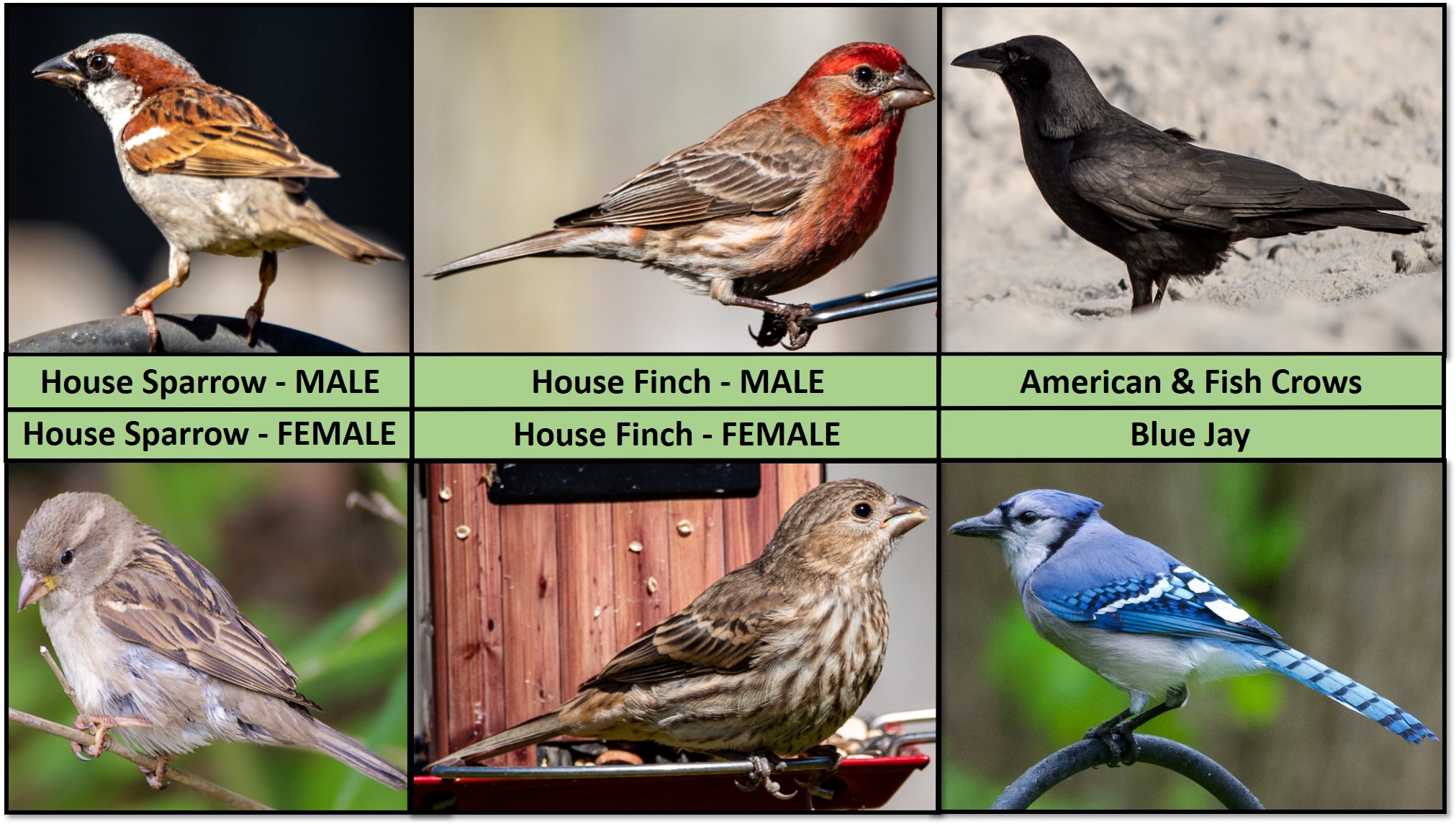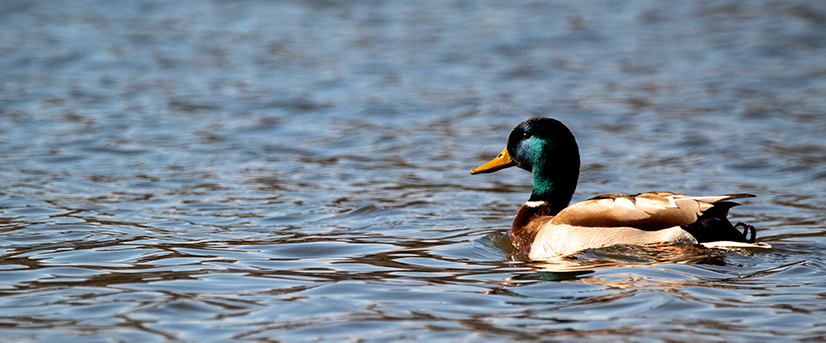Birds play an important role in maintaining and spreading West Nile virus (WNV). Mosquitoes become infected with WNV when they feed on infected birds that carry the virus in their blood. After 1½ to 2 weeks, infected mosquitoes can then transmit WNV to people and other animals.
Tracking the virus in birds that have a high death rate from WNV alerts us to virus activity in a certain area of the state.
Signs of WNV illness in birds include weakness, sluggishness, shaking, seizures, inability to walk/fly/perch, blindness, or lack of fear of people.
You Can Help
Please help DHEC monitor West Nile virus activity in South Carolina. Between mid-March through the end of November, please submit freshly dead (non-injured, non-decayed) Crows, Blue Jays, House Finches, House Sparrows, and other songbirds. (See instructions below for submitting other types of birds.)
What Kinds of Birds Do We Test?
Between mid-March through November, when mosquitoes are most active in South Carolina, DHEC monitors WNV activity in birds. When we find evidence of WNV in birds, we contact the local mosquito control agency in the area where the bird was found. (That's if the area has a mosquito control agency - some S.C. communities do not.)
Our early warning gives the mosquito control agency an opportunity to help safeguard the health of residents by boosting mosquito control and reminding citizens to take steps to protect themselves from mosquito bites.
We mainly test these five types of birds:

- American Crows are 17-21 inches long and all black.
- Fish Crows look almost exactly like the American Crow except for their silkier appearance and slightly narrower build.
- Blue Jays are 9-12 inches long. Blue Jays are bright blue on top and whitish gray on the belly and chin, and have a gray-blue crest on the head. Their wings and tail are bright sky-blue with heavy black barring, and they have a black collar or "necklace" across the throat and around the head, and a black bill, legs, feet, and eyes.
- House Finches are 6 inches long. House finches are birds with grayish-brown upperparts, whitish lowerparts with streaks of brown, brown and gray wings with two narrow whitish bars, and brown uppertails. Male house finches are rosy red around the face, neck, and shoulders, as well as having a red rump. The red color sometimes extends down the belly and down the back between the wings. Variant males show the same markings, but in yellow or orange instead of red. Female house finches lack any yellow, orange, or red color and have a plain, unmarked face.
- House Sparrows are 5.5 to 6.5 inches long. Male house sparrows are brightly colored birds with gray heads, gray or white cheeks, black throats (or "bibs"), white collars, reddish-brown upperparts with black streaking, wings with a single white bar, and pale gray underparts. Female house sparrows are birds with buffy-brown upperparts with black streaking, wings with a single white bar, and dingy grayish-brown underparts.
Please do not submit grackles, which are black or brown birds that look a lot like crows, but are much smaller (11-13 inches long), with a purple or green sheen to their head depending on the angle and light.
Crows and Blue Jays (Corvids) are more likely to die from West Nile virus, which makes them good candidates for detecting the virus. However, the number of dead Crows and Blue Jays sent in for testing by the public has dropped over the past few years. Reasons for this drop might include decreased public participation, smaller bird populations due to West Nile virus die-offs, or an increase in survival rates.
House Finches and House Sparrows are not as likely to die from a West Nile virus infection as compared to Crows and Blue Jays, but they were chosen as target species because of their abundance and high infection rates compared to other birds.
When people submit birds other than Blue Jays, Crows, House Finches, and House Sparrows, we decide whether or not to test those on a case-by-case basis. We will not test birds that die as a part of a mass die-off at a single time and place, which indicates that illness was caused by something else other than WNV.
We will accept other types of birds from veterinarians affiliated with zoos, raptor rehabilitation centers, and similar facilities if WNV is suspected as the cause of illness.
Learn what to do if you find other types of dead birds that show no signs of injury or trauma.
How to Report Illness in Birds or Submit Dead Birds to DHEC
- Between mid-March and the end of November, submit any dead Blue Jays, Crows, House Finches, House Sparrows, and other songbirds found to your county office. Staff there will make sure the bird qualifies for testing and then send it to DHEC's lab in Columbia.
- Please submit only freshly dead wild birds that show no signs of physical trauma or decay. In other words, please do not submit roadkill or birds with missing eyes, an obvious odor, skin discoloration, feathers or skin that easily rub off, maggots, or gunshot or other types of wounds.
- To protect your own health, follow these instructions when picking up a dead bird:
- Do not touch a bird (dead or alive) with your bare hands. Either:
- Use gloves, or
- Pick the bird up with doubled clear plastic bags that have been turned inside out (covering your hand). Invert the bag over the bird (uncovering your hand) and seal the bird in the doubled plastic bags. If possible, use clear plastic or clear zipper bags so that the bird can be seen through the bags.
- Keep the bagged bird cool until it can be placed on ice or in a refrigerator. If you can not deliver the bird carcass to DHEC within 36 hours of collection, freeze it until you are able to deliver it or ship it.
- Complete the DHEC Dead Bird Submission Form and submit it, along with the dead bird, to your county office. When you fill out the form:
- Make sure to provide the physical location of the site where the bird was found - either an address or directions to the site, indicating distances from nearby intersections. If necessary, draw a map on the back of the form. We will not test a bird without clear information on where the bird was found.
- Do not fill out the boxed areas located at the top and bottom of the form - DHEC lab staff will complete those sections.
Getting Lab Results
Testing can sometimes take up to four weeks to complete based on our workload. Local staff will notify you of the results.
Reporting Other Types of Dead or Sick Birds
Other S.C. agencies also test or track certain types of sick or dead birds:
- For unexplained bird die-offs in flocks being raised for farming/agribusiness (Chickens, Turkeys, Quail, Pheasants, Ducks, Geese, or Emus), owners or farmers should call the Clemson University Livestock-Poultry Health Programs (CULPH) in Columbia and speak to a field veterinarian at (803) 788-2260.
- If you find sick or dead Bald Eagles and waterfowl, especially American Coots, at inland lakes or ponds between October and February, please report/submit them to the S.C. Department of Natural Resources (DNR) by calling (803) 734-3938. DNR tests these types of birds for Avian Vacuolar Myelinopathy (AVM). A bird suffering from AVM may have difficulty flying, swimming, walking, or show other signs of incoordination. DNR will arrange to have the birds tested for West Nile virus also. Please ask DNR to fax the Bureau of Labs a copy of the dead bird submission sheet so that we may keep track of the birds being tested. If you find a sick or dead Bald Eagle or Waterfowl and want to submit it to DNR, make sure to keep the carcass cold on gel ice packs, but do not freeze it.
- If you notice an unusual number of dead Raptors - Hawks, Falcons, Vultures, or Owls - please call DNR at (803) 734-3938.
